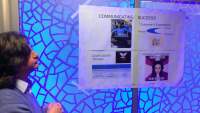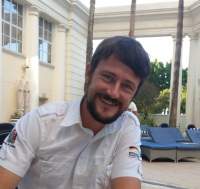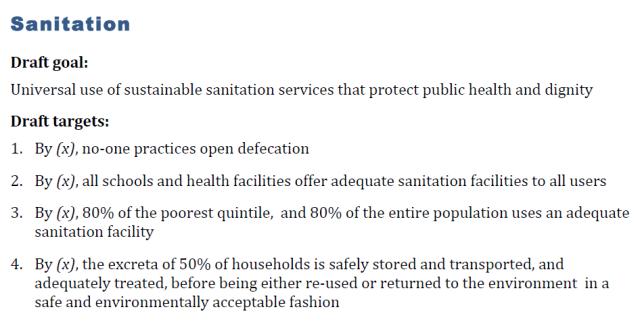- Forum
- categories
- Markets, finance and governance
- Global and regional political processes
- Sustainable Development Goals (SDGs), JMP monitoring
- Proposed indicators for post-2015 global sanitation monitoring?
Proposed indicators for post-2015 global sanitation monitoring?
28.1k views
- ndivine
-
Less
- Posts: 17
- Likes received: 1
Re: Mapping Youth Led Organisations and Mobilising Support for post-2015
Hope this email finds you well.
I will like to thank you all for endless support, contribution and inspiring project to enhance the voices of youths to be heard in your various communities.
Just a quick note , acting as Partnership for your organisation , with your support in all forms has really upgraded to High Level Platform such as UN focus on youth voices in post-2015 processes. I serve as the Global Youth Digital Advocate for Post-2015 Development Agenda with the focus to over come digital divide in reaching to most marginalised children, youth and communities in bringing their voices to the global development process. We need more advocates such as you
We are currently mapping youth led organisation and mobilising support for Post-2015 and will definitely encourage you all to sign up on the spreadsheet below to be part of the process.
For more information on this process and recent contributions from different youth leaders check links below:
www.worldwewant2015.org
www.un.org/millenniumgoals/beyond2015.shtml
docs.google.com/spreadsheet/ccc?key=0Aje...WFCRFNWY1VvVkE#gid=0
We encourage you to see these brilliant videos and create your own video and upload
Youth Voices in opsot-2015
1. MGCY (vimeo.com/49092094)
2. Youth Voices youth Leadership Academy Turkey ()
If you have specific question on Child and Youth Participation on Post-2015, write to Ravi Karkara (This email address is being protected from spambots. You need JavaScript enabled to view it.) and Ntiokam Divine (This email address is being protected from spambots. You need JavaScript enabled to view it.)
Please Log in to join the conversation.
You need to login to reply- dietvorst
-
 Less
Less- Posts: 93
- Karma: 13
- Likes received: 67
Re: The JMP Post-2015 indicators on WASH in schools are a step in the right direction
Why did we choose a different platform to host the JMP Post-2015 indicator debate and not this forum? Basically because we wanted to use the for/against debate functionality that the site offered. Choosing a provocative statement and asking people to either agree or disagree is a simple way to keep a discussion focussed and quickly collect and rate a wide range of arguments. The point about introductions is valid, though we had hoped that participants would fill in their profile when registering.
Information Manager
Programme Officer | IRC
+31 70 304 4014 | This email address is being protected from spambots. You need JavaScript enabled to view it. | www.ircwash.org
Skype cor.dietvorst | Twitter @dietvorst
Please Log in to join the conversation.
You need to login to replyfrom my understanding there is a difference between access and coverage, I thought I read it somewhere but I can´t remember where. And please correct if I´m wrong, I´m not sure, that is the reason I did´nt answer the question before.
Access: population with the possibility to use a toilet in a range of xxx (was it 10 min or 300 m?) / total population
excluding schools and workplaces. The count is from the place you sleep...I never understood very well that logic because it destroys the aim of organizations to build school toilets.. that has been a real problem in some cases)
Coverage: number of households with a toilet / total number of households
Regards
Christoph
Please Log in to join the conversation.
You need to login to reply- Elisabeth
-
Topic Author
- Moderator
- Freelance consultant since 2012 (former roles: program manager at GIZ and SuSanA secretariat, lecturer, process engineer for wastewater treatment plants)
Less- Posts: 3372
- Karma: 54
- Likes received: 932
Re: The JMP Post-2015 indicators on WASH in schools are a step in the right direction
(I refer to your posting from 14 Sept.)
You asked:
I have thought about it and I think there is no difference, it is 2 different words for the same thing. Or let's say access is measured by coverage. This is determined by household surveys. There could be, however, a difference between access and use. Maybe more people have access (theoretically) than are using facilities (in practice).Can one help me to distinguish between sanitation coverage and access? How do we measure coverage and access?
By the way, welcome to the forum, Arnold! I hope to see you here more often. You forgot to mention in your introduction that you have co-authored a new SuSanA case study on a large-scale UDDT project in Southwestern Uganda, reaching several thousand people with UDDTs in small towns (co-financed by Austrian Development Aid). If anyone is interested, please see this new case study here (still in draft mode):
www.susana.org/lang-en/case-studies?view...eitem&type=2&id=1558
At Cor Dietvorst:
Thanks for posting the results of that e-debate on school WASH and JMP monitoring here. The points made are very interesting and one can learn a lot. I am just wondering about these e-debates though. What is the advantage of using a separate e-debate platform as opposed to using this platform (for example)? The only advantage I see is that the "yes" and "no" are shown side by side in two columns. (what to do with "maybes"?). The disadvantage in my view is that one needs to get another login and that no introductions are made, i.e. one doesn't know who one is talking to or who is talking to me. Here on this type of forum, we get to know each other better I think. So I am just wondering what IRC's reasoning is for preferring the e-debate mode?
Regards,
Elisabeth
Freelance consultant on environmental and climate projects
Please Log in to join the conversation.
You need to login to reply- dietvorst
-
 Less
Less- Posts: 93
- Karma: 13
- Likes received: 67
Re: The JMP Post-2015 indicators on WASH in schools are a step in the right direction
Read a full summary of the e-debate at: www.washinschools.info/page/2098
Information Manager
Programme Officer | IRC
+31 70 304 4014 | This email address is being protected from spambots. You need JavaScript enabled to view it. | www.ircwash.org
Skype cor.dietvorst | Twitter @dietvorst
Please Log in to join the conversation.
You need to login to reply- tmsinnovation
-

- Moderator
- I manage the Decentralized Wastewater Management for Adaptation to Climate Change in Jordan (ACC Project) and previously coordinated the Climate-friendly sanitation services in peri-urban areas of Lusaka project in Zambia. My background is in Management, Economics and Information Systems.
Less- Posts: 162
- Karma: 4
- Likes received: 53
Re: Video presentation on the proposed indicators for post-2015 global sanitation monitoring
Please have a look at this great presentation from Darren Saywell (Plan International USA) which we filmed at the recent 16th SuSanA meeting in Stockholm, where he explains how the process works and where more consultation is required.
Please lets see more comments here on the forum in this regard.
Let us know if you have already submitted comments on
JMP (Joint Monitoring Program) has now published a so-called "Long list" for proposed goals, targets and indicators for Post-2015 MDG goal(s) on water and sanitation. And they are asking for feedback and comments by 20 September.
Here is the direct link to the pdf of the first presentation that Darren speaks to: www.susana.org/images/documents/04-meeti...kholm-draft27aug.pdf
Here is the direct link to the pdf of the second presentation that Darren speaks to: www.susana.org/images/documents/04-meeti...ion-in-stockholm.pdf
Regards
Trevor
Decentralized Wastewater Management for Adaptation to Climate Change in Jordan (ACC Project)
Project Manager
Deutsche Gesellschaft für
Internationale Zusammenarbeit (GIZ) GmbH
Ministry of Water and Irrigation, Shmeisani,
Amman
Jordan
Please Log in to join the conversation.
You need to login to reply- bitwire2010
-
Less
- Posts: 14
- Likes received: 2
Re: Coverage and access - what is the difference?
I am Arnold Asiimwe a Civil Engineer from Uganda, working with Water and Sanitation Development Facility South West (wsdf/sw) which is under the Min. of Water and Environment. I m employed as an Engineer in Charge of Sanitation.
I have just joined the forum and thank everybody for the generous contribution and sharing of knowledge and experience.
Can one help me to distinguish between sanitation coverage and access? How do we measure coverage and access?
MDG number 7 target 10 talks about sustainable access, is this enough when the coverage is low/small?
Thanks
Regards
Arnold Asiimwe Eng.
Please Log in to join the conversation.
You need to login to replyOur experience is that at current prices and with a minimum life of thirty years, the cost per person for an ecosan is £2 (€2.40) per person per year. We think it is very good value. Unfortunately, society at large is only interested in short term gains, not long term, and as yet no sustainable system can deliver at the speed politicians need. It is important to remember that this will be a political requirement/expedient, and most western politicians know they have a 4/5 years shelf life.
Please Log in to join the conversation.
You need to login to reply- Elisabeth
-
Topic Author
- Moderator
- Freelance consultant since 2012 (former roles: program manager at GIZ and SuSanA secretariat, lecturer, process engineer for wastewater treatment plants)
Less- Posts: 3372
- Karma: 54
- Likes received: 932
Re: Long list now out for comments by 20 September 2012
Also here you see the debate set up by IRC about the same Long List, here now with a focus on WASH in schools. Very interesting arguments on both sides:
www.createdebate.com/debate/show/Are_the..._the_right_direction
The title of their debate is: Are JMP Post-2015 indicators on WASH in schools a step in the right direction?
Freelance consultant on environmental and climate projects
Please Log in to join the conversation.
You need to login to reply- Elisabeth
-
Topic Author
- Moderator
- Freelance consultant since 2012 (former roles: program manager at GIZ and SuSanA secretariat, lecturer, process engineer for wastewater treatment plants)
Less- Posts: 3372
- Karma: 54
- Likes received: 932
Re: Long list now out for comments by 20 September 2012
These are interesting points that you raise. Is "sustainable sanitation" always more expensive than "conventional sanitation" (just to give one example: UDDTs compared to pit latrines)? Yes, if you only look at the construction costs. No if you look at a whole of life cost, and if you make the borders of the analysis wider, i.e. to also include those costs related to groundwater pollution, health problems from flies etc. But who looks beyond the construction costs? Not many people.
This was also raised in a posting by Jonathan Parkinson here on the forum:
forum.susana.org/forum/categories/69-rel...eeting-in-cairo#1911
As to your other question: in the proposed Goal they speak about sustainable sanitation. But in the target, the term "adequate sanitation" pops up. I can kind of follow that logic because to measure access we need to have a situation of either yes or no. There cannot be any "maybes". We have a nice definition for sustainable sanitation - see SuSanA vision document:
, but it cannot be measured in terms of "yes, sustainable" or "no, not sustainable". Because it gives a direction, a vector, not a final state. And that is done like this on purpose.In order to be sustainable, a sanitation system has to be not only economically viable, socially acceptable, and technically and institutionally appropriate, it should also protect the environment and the natural resources.
Whereas the attempt to define adequate sanitation (see posting above), would allow someone to walk around with a check list, check the different criteria, such as number of people sharing, open 24 hours per day, 7 days per week and so forth and then decide: "access gained yes or no". These criteria could be seen as a proxy to measure whether the sanitation system is likely to be sustainable and used in the longer term by all or not. Which is why that definition of adequate sanitation is very crucial (and not yet ideal in my opinion, e.g. the bullet points "safe" and "durable" would be subjective to assess).
Regards,
Elisabeth
Freelance consultant on environmental and climate projects
Please Log in to join the conversation.
You need to login to replyAlthough they are being called the Sustainable Development Goals I see the word sustainable only once, and then it is replaced by adequate; this is my biggest bugbear. Personally I would like to see the word sustainable replace the word adequate, but I take the long view. There is a political expediency here as well that we have to consider. Do we dilute our suggestions to create a mass level (pits) with a parallel level (sustainable) that at some point wil overtake the mass level, but is more politically acceptable? Or do we suggest that a percentage of the overall target be sustainable so we can prove it is scaleable?
I would be interested to see what others think.
Please Log in to join the conversation.
You need to login to reply- Elisabeth
-
Topic Author
- Moderator
- Freelance consultant since 2012 (former roles: program manager at GIZ and SuSanA secretariat, lecturer, process engineer for wastewater treatment plants)
Less- Posts: 3372
- Karma: 54
- Likes received: 932
Re: Long list now out for comments by 20 September 2012
You may well have seen it already via other channels, but I wanted to draw your attention to the fact that the JMP (Joint Monitoring Program) has now published a so-called "Long list" for proposed goals, targets and indicators for Post-2015 MDG goal(s) on water and sanitation. And they are asking for feedback and comments by 20 September.
Here is the document:
Please log in or register to see it.
At the SuSanA meeting, we were fortunate that Darren Saywell gave an explanation of the current situation and thinking behind this for the Sanitation working group where he is a core group member (I am a reference group member). I encourage you to look at the files we uploaded for Darren's presentation here on the SuSanA website:
www.susana.org/lang-en/meetings/16th-sus...ing-stockholm-sweden
You can also see all the information and JMP's discussion forum here:
www.wssinfo.org/post-2015-monitoring/working-groups/sanitation/
At the SuSanA meeting, we thought it would be nice if SuSanA as a whole could give a joint response/statement. Now I don't know if that is still feasible given that we only have one week left, but we could try. E.g. if some or even many SuSanA members comment here, then we could merge comments and send them in as a "SuSanA response".
Note that e.g. WSUP have already provided a response and this is visible on the JMP website here:
www.wssinfo.org/post-2015-monitoring/wor...tx_displaycontroller[target_group]=sanitation
As a guidance, ensure that you click through Guy's presentation which he gave at the Stockholm World Water Week (link as given above or see direct link here: www.susana.org/images/documents/04-meeti...kholm-draft27aug.pdf)
It helps to understand that there is an MDG process and (new) an SDG process (Sustainable Development Goals). Maybe in future we will only have SDGs (which are also of relevance to developed countries) and no more MDGs.
Please also note that this Long List which we are invited to comment on, will need to be massively condensed. Out of all the proposed goals and targets only 1-2 will remain in the end, so clever ideas of merging several into one would surely be a good thing. I suppose the number of indicators could be somewhat larger, but maybe not more than 4? (just my guess)
If you have any questions about this process please ask. I look forward to reading your comments.
Some of my own personal opinions on this and feedback which I would possibly give:
- I like for sanitation that we no longer define access based on which technology we "allow" and which we don't but according to the function and characteristics, based on human rights criteria (accessibility, availability, affordability etc. (actually the affordability criterion is not included; I wonder why not)).
- I find it really difficult to get my head around how all these possible goals and targets could be merged into 1 or 2.
- I don't like that we are now talking about absolute numbers (80% use...) instead of relative numbers like before (reduction by half of those people without access...). I was told by Chris Zurbrügg that this is mainly because of the difficulties in establishing the correct baseline. For the current MDGs, the baseline is actually 1990.
- The definition of "adequate sanitation" will be extremely important and must be well thought out.
Regards,
Elisabeth
Freelance consultant on environmental and climate projects
Attachments:
-
 NeuesBild5.jpg
(Filesize: 37KB)
NeuesBild5.jpg
(Filesize: 37KB)
-
 NeuesBild4.jpg
(Filesize: 33KB)
NeuesBild4.jpg
(Filesize: 33KB)
Please Log in to join the conversation.
You need to login to reply- Forum
- categories
- Markets, finance and governance
- Global and regional political processes
- Sustainable Development Goals (SDGs), JMP monitoring
- Proposed indicators for post-2015 global sanitation monitoring?







